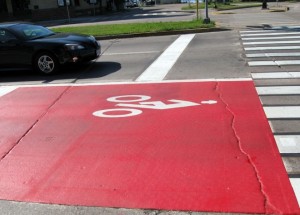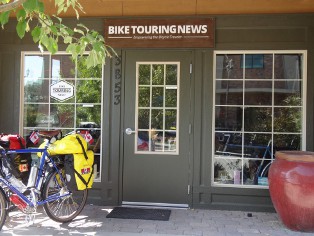 If bicycles are to ever start being considered legitimate forms of transportation one of the first things that needs to happen is for bicyclers to own their rights and responsibilities. That means, among other things, riding in the street and not on the sidewalk. Making sure drivers see them and know what their intentions are. Using the bike lane if there is one and if not, taking their place in the traffic lane. Most state laws allow this unless traffic is being held up. And most people are not psychopaths who will intentionally mow down a bicycle. In fact, most accidents happen when drivers are not expecting to see a bicycle, as when one suddenly enters the street from a sidewalk.
If bicycles are to ever start being considered legitimate forms of transportation one of the first things that needs to happen is for bicyclers to own their rights and responsibilities. That means, among other things, riding in the street and not on the sidewalk. Making sure drivers see them and know what their intentions are. Using the bike lane if there is one and if not, taking their place in the traffic lane. Most state laws allow this unless traffic is being held up. And most people are not psychopaths who will intentionally mow down a bicycle. In fact, most accidents happen when drivers are not expecting to see a bicycle, as when one suddenly enters the street from a sidewalk.
Following all the laws all the time is a challenge though since the infrastructure is designed for cars. One example is the sensors, loops of wire buried in the pavement of the travel lane near the stop line, which detect vehicles at intersections and tell the lights when to change. They are meant to detect metal but most of them are not super sensitive and don’t detect bicycles. Besides, they are in the traffic lanes and not on the side of the road or in the bike lanes. The humantransport.org website has a good article about how to make these detectors detect a bicycle.
Intersections in Pleasanton, California, have been outfitted with radar that not only detect bicycle traffic to trigger green lights, but differentiate between bicycles and cars.
The devices, called Intersectors, have been installed at eight intersections across the city alongside bike lane and pavement projects. They use a combination of microwave and presence sensors to detect a vehicle, and offer enough precision to determine whether a vehicle has two, four or more wheels. Because it can detect what kind of vehicle is about to cross, it will adjust signal timing accordingly (as seen in the video).
The wired.com website has this article on their Autopia page
The Bike Hermit is encouraged. As more people start to actually use bicycles, and other people see them and maybe think that they could do it too, the idea becomes more mainstream. Bicycles are a legitimate, efficient mode of transportation but still one that most people never consider. It’s easy to walk to the garage and hop in the car to go to the store. It’s actually easier, many times, to hop on the bicycle. And it’s almost always easier to find a parking spot!

Linda Paul January 13, 2012, 8:15 am
Keep up the biker education, Jim. I think we all need frequent reminders. My biggest fear as a driver is the cyclist who pedals the sidewalk upstream on a one-way street. Drivers coming out of driveways or entering from a sidestreet are focused on car traffic coming from the expected “one-way” direction. Looking in the opposite direction is usually an automatic last-minute reflex, but not one which registers a fast moving vehicle coming up the sidewalk until it is too late.
The other thing I struggle with is taking ownership of the traffic lane where no bike lane exists. I tend to hug the side of the road, hoping to let drivers pass me, but then I have to be doubly watchful for parked cars and the potential dangers they present.
Bike Hermit January 13, 2012, 10:43 am
Linda,
Taking ownership of the traffic lane requires a leap of faith sometimes. While Idaho law states the cyclist must ride ‘as close to the right as practicable to the right-hand curb or edge of roadway’ It does not mean that the cyclist must ride along the edge of the roadway. This is often more dangerous position as there is debris along the curb, there is no room for emergency maneuvering. More good tips are on the Boise Street Smart Cycling site.
Aushiker January 14, 2012, 2:40 am
Here in Western Australia, we have a lot of traffic lights that have painted diamonds and a cyclist symbol on the road indicating the best position for cyclists to take to “trip the lights.” It also happens to the primary position and I would suggest also legitimises cyclists being there.
I cannot find a photo to link to but this from the Western Australian Department of Transport illustrates what is on road and how it works.
Hope this adds to the discussion.
Thanks
Andrew
Bike Hermit January 14, 2012, 9:09 am
Andrew,
Wow, thanks for that link. Just painting diamonds with a cyclist symbol appears to be an easy, relatively cheap retrofit for the sensors originally designed for cars, and as you said, would give bicycling more credibility. I also like the head start box for riders wanting to turn right (which would need to be for left-turning riders in the states)
Don January 19, 2012, 3:53 pm
Jim, I actually don’t mind the way things are now. If cyclists are given everything they could ever dream of on the streets and roads of America I am quite sure there will be a hefty tax bill and a laundry list of new laws governing there proper use. I like being able to use a stretch of sidewalk when it suits me, use the left hand turn lane if that works, ride in traffic if it’s moving slow enough or cut through a parking lot to save time. Freedom is one of the best things about cycling and danger will always be a part of it. (Did any of that fit the topic?)
Bike Hermit January 19, 2012, 4:20 pm
Good points, Don.